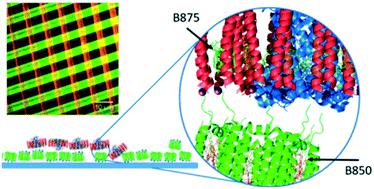Our official English website, www.x-mol.net, welcomes your
feedback! (Note: you will need to create a separate account there.)
Excitation energy transfer between monomolecular layers of light harvesting LH2 and LH1-reaction centre complexes printed on a glass substrate.
Lab on a Chip ( IF 6.1 ) Pub Date : 2020-06-11 , DOI: 10.1039/d0lc00156b Xia Huang 1 , Cvetelin Vasilev , C Neil Hunter
Lab on a Chip ( IF 6.1 ) Pub Date : 2020-06-11 , DOI: 10.1039/d0lc00156b Xia Huang 1 , Cvetelin Vasilev , C Neil Hunter
Affiliation

|
Light-harvesting 2 (LH2) and light-harvesting 1 – reaction centre (RCLH1) complexes purified from the photosynthetic bacterium Rhodobacter (Rba.) sphaeroides were cross-patterned on glass surfaces for energy transfer studies. Atomic force microscopy (AFM) images of the RCLH1 and LH2 patterns show the deposition of monomolecular layers of complexes on the glass substrate. Spectral imaging and fluorescence life-time imaging microscopy (FLIM) revealed that RCLH1 and LH2 complexes, sealed under physiological conditions, retained their native light-harvesting and energy transfer functions. Measurements of the amplitude and lifetime decay of fluorescence emission from LH2 complexes, the energy transfer donors, and gain of fluorescence emission from acceptor RCLH1 complexes, provide evidence for excitation energy transfer from LH2 to RCLH1. Directional energy transfer on the glass substrate was unequivocally established by using LH2-carotenoid complexes and RCLH1 complexes with genetically removed carotenoids. Specific excitation of carotenoids in donor LH2 complexes elicited fluorescence emission from RCLH1 acceptors. To explore the longevity of this novel nanoprinted photosynthetic unit, RCLH1 and LH2 complexes were cross-patterned on a glass surface and sealed under a protective argon atmosphere. The results show that both complexes retained their individual and collective functions and are capable of directional excitation energy transfer for at least 60 days.
中文翻译:

在玻璃基板上印刷的光收集LH2和LH1反应中心络合物的单分子层之间的激发能转移。
从光合细菌球形红球菌(Rba。)提纯的光捕获2(LH2)和光捕获1-反应中心(RCLH1)复合物在玻璃表面上进行交叉图案化以进行能量转移研究。RCLH1和LH2模式的原子力显微镜(AFM)图像显示了复合物的单分子层在玻璃基板上的沉积。光谱成像和荧光寿命成像显微镜(FLIM)显示,在生理条件下密封的RCLH1和LH2复合物保留了其天然的光收集和能量转移功能。LH2络合物,能量转移供体的荧光发射的幅度和寿命衰减的测量以及受体RCLH1络合物的荧光发射的增益提供了从LH2到RCLH1的激发能量转移的证据。通过使用LH2-类胡萝卜素复合物和RCLH1复合物以及经过基因去除的类胡萝卜素,可以明确地确定玻璃基材上的定向能量转移。供体LH2复合物中类胡萝卜素的特异性激发引起RCLH1受体发出荧光。为了探索这种新颖的纳米印刷光合作用单元的寿命,将RCLH1和LH2配合物在玻璃表面上进行交叉构图并在保护性氩气气氛下密封。结果表明,两种配合物均保留其各自的功能和集体功能,并且能够定向激发能量转移至少60天。RCLH1和LH2配合物在玻璃表面上进行交叉构图,并在保护性氩气气氛下密封。结果表明,两种配合物均保留其各自的功能和集体功能,并且能够定向激发能量转移至少60天。RCLH1和LH2配合物在玻璃表面上进行交叉构图,并在保护性氩气气氛下密封。结果表明,两种配合物均保留其各自的功能和集体功能,并且能够定向激发能量转移至少60天。
更新日期:2020-07-14
中文翻译:

在玻璃基板上印刷的光收集LH2和LH1反应中心络合物的单分子层之间的激发能转移。
从光合细菌球形红球菌(Rba。)提纯的光捕获2(LH2)和光捕获1-反应中心(RCLH1)复合物在玻璃表面上进行交叉图案化以进行能量转移研究。RCLH1和LH2模式的原子力显微镜(AFM)图像显示了复合物的单分子层在玻璃基板上的沉积。光谱成像和荧光寿命成像显微镜(FLIM)显示,在生理条件下密封的RCLH1和LH2复合物保留了其天然的光收集和能量转移功能。LH2络合物,能量转移供体的荧光发射的幅度和寿命衰减的测量以及受体RCLH1络合物的荧光发射的增益提供了从LH2到RCLH1的激发能量转移的证据。通过使用LH2-类胡萝卜素复合物和RCLH1复合物以及经过基因去除的类胡萝卜素,可以明确地确定玻璃基材上的定向能量转移。供体LH2复合物中类胡萝卜素的特异性激发引起RCLH1受体发出荧光。为了探索这种新颖的纳米印刷光合作用单元的寿命,将RCLH1和LH2配合物在玻璃表面上进行交叉构图并在保护性氩气气氛下密封。结果表明,两种配合物均保留其各自的功能和集体功能,并且能够定向激发能量转移至少60天。RCLH1和LH2配合物在玻璃表面上进行交叉构图,并在保护性氩气气氛下密封。结果表明,两种配合物均保留其各自的功能和集体功能,并且能够定向激发能量转移至少60天。RCLH1和LH2配合物在玻璃表面上进行交叉构图,并在保护性氩气气氛下密封。结果表明,两种配合物均保留其各自的功能和集体功能,并且能够定向激发能量转移至少60天。









































 京公网安备 11010802027423号
京公网安备 11010802027423号